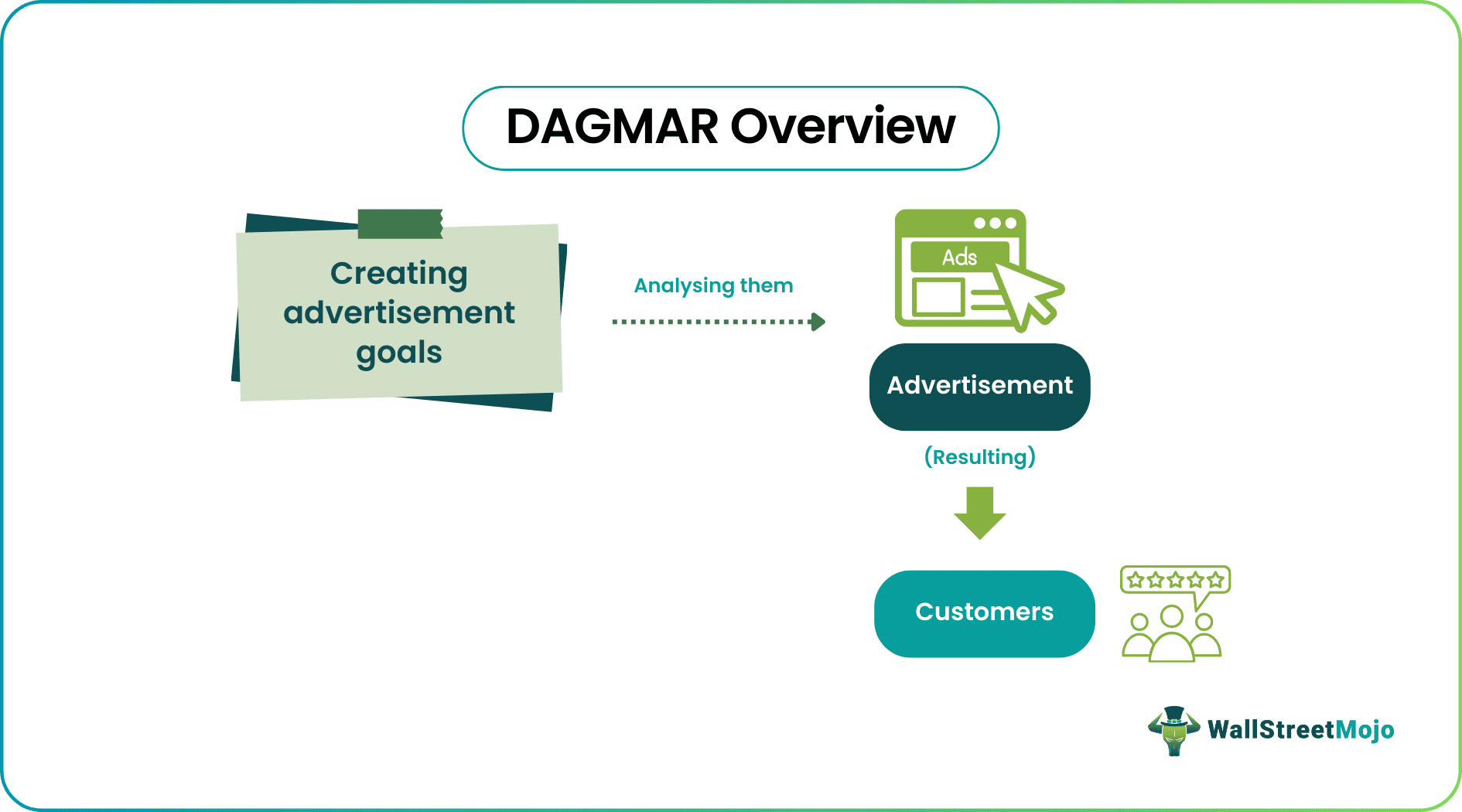Table Of Contents
What Is DAGMAR?
Defining advertising goals for measured advertising results, or DAGMAR refers to the collection of objectives for measuring an advertisement's effectiveness. It serves the purpose of enhancing the advertising campaign to build better customer relations.

DAGMAR approach helps the advertisers to decide clear advertising objectives, track & analyze results, and achieve target audience and concrete goals. However, issues like a hefty advertising budget lead to criticism of the DAGMAR approach.
Key Takeaways
- The DAGMAR meaning implies a marketing model that helps set advertising goals and measure effectiveness. Its primary objective lies in building customer relations rather than sales.
- Russell Colley published this method in a book called "Defining advertising goals for measured advertising results" in 1961. Later, Solomon Dutka revised this edition in 1995.
- The two phases of this approach include defining the advertising goals and measuring their performance.
- Four objectives of the DAGMAR approach include awareness, comprehension, conviction, and action.
DAGMAR Approach Explained
The DAGMAR model is a marketing approach that helps companies achieve their advertising goals. In addition, it acts as a guide to assessing a company's current advertising tactics.

The second half of the 20th century witnessed the mark of this method. After World War II, advertising expenses increased massively (i.e., 33 times). From 1961 to 1992, the sales of cable and direct-satellite televisions multiplied by 11 times. Increased advertisements also hyped the competition among the rivals. During this situation, the American advertising business saw a boost in advertising budget, increasing from $12 billion to $130 billion.
This concept has enabled marketers to increase the utility of their advertisements. The purpose of this advertising approach was not only to sell products but also to build a strong audience. Therefore, it focused more on developing relations with the customers. Many companies are using the DAGMAR marketing model to deliver their motive to the people. Through this approach, companies could easily deliver their message to consumers. Hence, it played a vital role in building brand equity and corporate image.
Thus, the DAGMAR approach has a lot of perks to offer to the companies. This model increases the productivity of a company's communication efforts. It helps a company save money compared to salesperson advertising.
Phases
Let us look at the breakdown of the DAGMAR approach:
1. Defining the Advertising Goals
Often companies consider advertising and marketing goals the same. Advertising is a part of marketing that deals with brand image. Although they aim to generate sales, in reality, they differ from each other. Therefore, it is important to define the advertising goals of the company. And, to define them, they must clearly understand what they want to achieve from this advertisement.
For example, a soap detergent company wants to increase its sales from 10% to 15%. So, their advertising goal will highlight that their detergent is better than other companies.
2. Measured Advertising Results
Measuring advertising results refers to systematically analyzing and evaluating a particular advertisement. First, it helps the company to understand the effectiveness of its advertisement. Then, it answers questions like how many customers saw their ads, the number of leads and sales generated, and other similar questions.
In the 1920s, the Audit Bureau Of Circulations helped the firms get accurate figures about the advertisement sold and printed. Next, companies check whether the advertisement was able to make customers take necessary actions. Then, finally, they analyze whether the ad was able to change the customer's perspective about their brand.
DAGMAR Model Objectives
The objective and goal are interchanging words, but they mean different things. While the former has a broader aim, the latter is time-specific but is. Advertising should not aim to get itself noticed, read, or heard. Instead, it should focus on changing the customer's mindset. It creates brand awareness.
Let us look at the objectives of the DAGMAR approach for effective results:
1. Awareness
Awareness is a prime aspect of creating a positive impression in customers' minds. Before buying a product, the customer should know the brand, new product launch, and new offers. Good brand awareness often makes customers feel connected to the company's objectives. Therefore, the companies should build such an ad that reaches their target audience.
2. Comprehension
Awareness alone cannot result in effective advertisement results. The company needs to comprehend (detail) the product information. Additionally, it needs to supply relevant information about the product features.
For example, Dell, a technology company, is launching an advertisement for its new laptop. They highlight the laptop features like enhanced processors, a protected screen, and improved storage.
3. Conviction
Here, the customers will decide whether they should buy the product or not. They often make choices through comparison with similar products. Then, if the customer finds the product interesting and worthy, they might try it. At this stage, the advertisement tries to convey its message to the target audience.
For example, in 2020, Facebook Meta, another technology company, projected an advertisement where two users helped a lady to start her own business. Slowly, many users joined hands and helped her grow her shop with the help of Facebook.
4. Action
The final step is to enact the buying decision. This step motivates the customers to buy the product.
For example, before launching a new iPhone, Apple, a company specializing in consumer electronics, tries to push its ads among the target audience. As a result, it creates hype about the product. So, the customer buys the product if they find it interesting.
Example
Let us look at the DAGMAR example to understand the concept better.
In 2014, a soft drink company, Coca-Cola, devised a twist advertisement campaign to deliver a beautiful message. They manufactured coke bottles that would open when two people twisted them. Earlier, people were shy to make friends, but after this initiative, they had to talk with others to open the bottle. Here, Coca-Cola targeted college students.
Thus, there were many coke vending machines installed in Australian institutions. Students brought the coke bottle but were confused with the opening system. After realizing the twist, they reached out to another classmate for help. With this process, they started making friends.
In this manner, the company hit its advertising objective of encouraging coke sales by creating bonds between people. As a result, they were successful in achieving their campaign goals.

